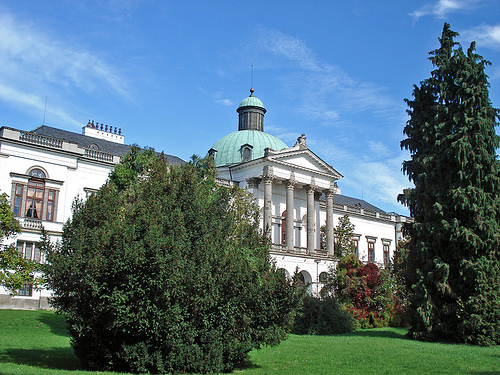

Location: 56 km (35 mi) Northeast of Trnava Map
Topoľčianky Castle is a historic fortress situated 56 km (35 mi) Northeast of Trnava in Slovakia. Topoľčianky Castle was originally a Gothic castle constructed in the middle 13th century. It was later reconstructed in Renaissance fortress. During Hussite Wars the castle was one of key bases for the Hussite troops. The castle was badly damaged during wars in the 18th century and abandoned. In the 19th century a manor was constructed on the ruins of the former formidable citadel by the orders of Count Ján Keglevich. It commonly served as a summer house for the Habsburg royal family.
They are located in Tekov, in the northern tip of the Danubian Lowland, below the southern tip of the Tribeč Mountains. The Hostiansky stream and its right-hand tributary Leveš flow through the village. From Zlaté Moraviec, the road II / 511 leads to the village, which continues through Skýcov to Veľké Uheriec.
Topoľčianky are documented in writing in 1293, but archaeological
finds confirm the settlement of the site as early as 6-7. century. At
the site of the current castle, there used to be a guard fortress
surrounded by a moat. In the 14th century, Comes Haslav obtained a
permit to pan for gold in the local stream, followed by a short period
of expansion of the village, in which a parish church and fortified
mansions were added. In the 16th century, local lords disagreed with the
owners of Hrušov Castle, which culminated in the collapse of
Topoľčianky, the massacre of part of the population and the burning of
the manor with the help of the Turks.
Ján Topoľčiansky had a new
fortress with a courtyard and two mayors built, and subsequently in 1561
Topoľčianky became a county town. Three years later, the establishment
of the school is also mentioned. Gradually, the brickyard was expanded,
barracks were added and the course of the stream was also changed. After
the extinction of the family at the beginning of the 17th century, the
property was auctioned off in 1616 and Baron Ladislav Petho-Heteši,
whose daughter Anna was the wife of Count Pavel Rákoci, became the new
owner. Their son Ladislav and his wife Elizabeth rebuilt the manor house
into a dignified mansion with the courtyard as we know it today.
Emperor Leopold I granted the town the right to hold fairs, which
stimulated the development of crafts, fruit growing and horticulture. In
1686, the Carmelite religious fraternity was established here, and since
that year, pilgrimages to the Virgin Mary of Carmel have also been
dated. In 1698, a hospital, an old house and an orphanage were added.
During the anti-Habsburg uprisings, Francis II was temporarily in the
manor. Rákoci, who escaped the imperial army in 1708. Count Karol Zichy
had a brewery and a sawmill built in Topoľčianky.
In 1723 the
seat of the county moved to Zlaté Moraviec and subsequently in 1851 the
district. The manor was enlarged thanks to Count Jozef Keglevič de
Buzin, who called in experts in fruit growing, vegetable growing and
viticulture from his native Croatia. After his death, the property
passed into the administration of Count Ján Nepomuk, who had a new
church built, in 1805 a statue of Ján Nepomucký, had the castle rebuilt
to its current form and cultivated the previously neglected park.
The last owners of the Topoľčianky in 1890 were the Habsburgs, who
raised the castle and its surroundings. Archduke Joseph August of
Habsburg abolished all farm buildings near the manor, added expensive
furniture to the manor, expanded the park, and established several
lakes. A significant turning point in the history of the town occurred
on November 20, 1895, when operation began on the railway line from
Šurian. Jozef August showed his relationship with nature by expanding
the forests, building a hunting lodge, establishing a game house and
riding school.
Since 1916, there has been a narrow-gauge forest
railway in Topoľčianky for timber weighing. At a length of 37.4 km, it
reached the surrounding valleys, led through the Žitava and Žitavice
valleys, one of the branches led all the way to Žiar. It was abolished
in 1959.
After the First World War and the establishment of the
Czechoslovak Republic, the state bought the local property, which began
the modern history of Topoľčianky.